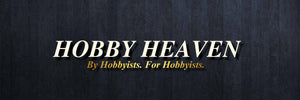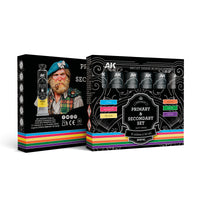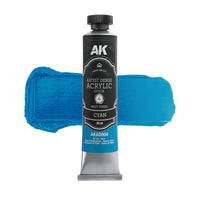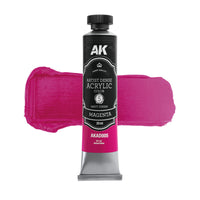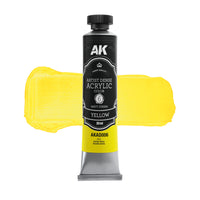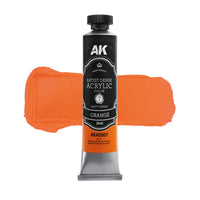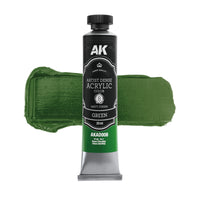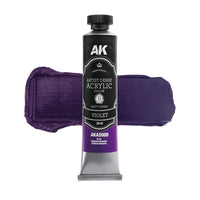AK Interactive Primary & Secondary Acrylic Paint Set – 6x20ml Tubes | AKAD102
AK Interactive Primary & Secondary Set
AKAD102 - 6x 20ml Dense Acrylic Paint Tubes
The perfect color theory foundation set. Create unlimited color possibilities with these essential primary and secondary hues.
🎨 The Color Wheel Essentials
The AK Interactive Primary & Secondary Set (AKAD102) provides the fundamental building blocks of color theory in a single comprehensive collection. This essential set contains the three primary colors (Cyan, Magenta, Yellow) and three secondary colors (Orange, Green, Violet) needed to create virtually any color in your artistic palette.
For both professional and amateur painters, this set is a must-have foundation. With these six colors plus black and white (not included), you can effectively paint anything by applying basic color theory principles. The carefully calibrated hue selection ensures perfect harmony across your entire project, whether you're painting miniatures, scale models, or fine art pieces.
✨ Superior Quality
- Pure, vibrant pigments for true color mixing without muddy results
- Exceptional opacity for excellent coverage with fewer coats
- Perfect color balance for predictable mixing results
- Smooth, dense consistency ideal for detailed work
- Matte finish perfect for miniatures and scale models
- 100% acrylic emulsion base compatible with all acrylic additives
🎭 Set Contents
This comprehensive set contains the perfect selection of primary and secondary colors, providing you with the essential framework to create unlimited color possibilities.
6 x 20ml Professional Metal Tubes:
🌈 Color Theory in Practice
Primary Colors
The three primary colors in this set (Cyan, Magenta, and Yellow) are the foundation of all color mixing. These cannot be created by mixing other colors and are the purest form of pigment. With these three colors alone, you can create a wide spectrum of hues through proper mixing.
Secondary Colors
The three secondary colors (Orange, Green, and Violet) are created by mixing adjacent primary colors. While you could mix these yourself, having them premixed ensures consistent color accuracy and saves time. These colors are perfect for creating vibrant, clean hues in your artwork.
🎨 Color Mixing Guide
*Complementary colors: Cyan+Orange, Magenta+Green, Yellow+Violet
🖌️ Advanced Techniques
💎 Glazing with Primaries
Create depth and richness by applying thin glazes of primary colors over base coats. Dilute your paint with medium (3:1 medium to paint) and apply in thin, transparent layers. Yellow over red creates a fiery orange glow; cyan over green creates deep aquatic tones; magenta over blue creates rich purple shadows.
🎭 Color Modulation
Create visual interest and depth by applying subtle color shifts across large surfaces. Rather than painting a vehicle in a uniform green, use slight variations by mixing in small amounts of complementary colors (violet for shadows, yellow for highlights). This creates a more dynamic, realistic appearance.
🌓 Complementary Shadows
Create rich, vibrant shadows by using complementary colors rather than black. For orange areas, use violet for shadows; for yellow areas, use violet (more blue-toned); for green areas, use magenta. These create more visually interesting and dynamic shadows than using black or gray.
🌟 Split Complementary Schemes
Create harmonious color schemes by using one main color and the two colors adjacent to its complement. For example, use green as your main color with violet and orange-red as accents. This creates a balanced, visually pleasing composition with just enough contrast to make details pop.
📋 Perfect For
Miniature Painters
Create vibrant, harmonious color schemes across your armies and character models with perfect color consistency.
Scale Modelers
Mix exact color matches for historical vehicles and create subtle variations for weathering and highlights.
Fine Artists
Achieve color harmony in your compositions with these pure, mixable primary and secondary colors.
Beginners
Learn color theory with a perfectly balanced set of primary and secondary colors for predictable mixing results.
🔍 Technical Specifications
❓ Frequently Asked Questions
Why use Cyan, Magenta, and Yellow instead of Red, Blue, and Yellow?
Cyan, Magenta, and Yellow are true primary colors in the subtractive color model, which is what applies to physical paints. These colors provide a wider color gamut and cleaner mixes than traditional RYB primaries, allowing you to create more vibrant secondary and tertiary colors with less muddiness.
Why do I need the secondary colors if I can mix them from primaries?
While you can create secondary colors by mixing primaries, having premixed secondary colors ensures perfect color consistency across your projects. They also provide pure, vibrant versions of these colors that can sometimes be difficult to achieve through mixing. Additionally, having these colors ready saves you time and lets you focus on your artwork.
Can I use these for airbrushing?
Yes! These paints can be thinned for airbrush application using an appropriate acrylic airbrush medium. The high pigment load ensures good color strength even when diluted for airbrushing. For best results, thin with a ratio of 1:1 or 1:2 (paint to medium) depending on your desired opacity.
Unlock Unlimited Color Possibilities
The AK Interactive Primary & Secondary Set (AKAD102) provides the color theory foundation every painter needs. Create endless color variations with perfect harmony and consistency across all your artistic projects.
Add to cart now to experience the versatility of premium quality primary and secondary acrylic paints.
Our brands















